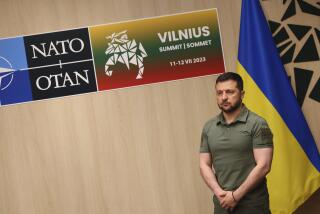NATO Must Disarm the Kosovo Liberation Army--Now
- Share via
The future role of the Kosovo Liberation Army has become the blind spot in the Kosovo peace plan. NATO is attempting to shed light on the issue by meeting with KLA leaders to discuss “demilitarization,” but the ensuing debate has become more pedantic than practical. Under the current plan, NATO will still leave hundreds of thousands of small arms--assault rifles, handguns and grenades--in the hands of the KLA.
The term “demilitarization” has gradually replaced “disarmament,” both in the U.N. Security Council resolution and at NATO headquarters. In a Defense Department briefing on June 15, Pentagon spokesman Kenneth Bacon explained the difference: To disarm means to take weapons away from an army. To demilitarize means to disband the army, leaving some of the people with some weapons--small weapons, basically.
A NATO plan to demilitarize is a weak compromise. The KLA is armed not with tanks and fighter planes, but with light weapons funneled in from looted Albanian arsenals and through the black market. An estimated 1 million AK-47 asssault rifles were stolen during the Albanian financial collapse of 1997 and are still circulating around Albania and Kosovo. To keep the weapons flowing, a close relationship has evolved between drug traffickers and arms smugglers. In Switzerland alone, 500 Kosovo or Macedonian Albanians are imprisoned for arms or drug trafficking and another 1,000 are under indictment.
As long as officials fail to address Kosovo’s light weapons, KLA fighters with guns will erode the control of the international peacekeeping force, or KFOR. Reports indicate that the KLA has installed checkpoints, seized Serb weapons and harassed departing troops. Near Gnjilane, 200 KLA fighters refused to hand their guns over to French troops, preferring to retreat into the mountains. In Prizren, Kosovo fighters can be found directing traffic with AK-47s in hand and holding press conferences declaring the city under KLA control in defiance of KFOR’s mandate.
While viewing the misery and tragedy of the Kosovo conflict, it was hard to deny the KLA the means to defend itself. Many Western nations turned a blind eye to the arms shipments. But now that a peace deal has been reached, the KLA must hand over its role as guarantor of security to the international peacekeeping force and give up its weapons. However, many members of the KLA are retaining their arms in hopes of achieving independence.
There is no doubt that weapons collection will be politically sensitive and logistically difficult. But leaving the arms in circulation will only create problems later on. The weapons could be used to carry out revenge attacks on Kosovo Serbs or ignite tensions elsewhere in Serbia or in Macedonia. The massive outflow of Serbs is a testimony to NATO’s failure to address these possibilities.
The local population isn’t the only potential target. In a tense situation, armed citizens or militias might turn their weapons on the peacekeepers themselves. It wouldn’t be the first time that peacekeepers have come under fire, a lesson the U.S. should have learned when 18 American peacekeepers were killed and some dragged through the streets of Mogadishu in 1993. No one had tried to disarm the Somali factions first.
NATO must utilize current talks in Tirana to build a comprehensive disarmament, demobilization and reintegration program that includes small arms and light weapons. As the recent breakdown of peace talks in Northern Ireland illustrates, clear disarmament agreements are essential to maintaining peace. It won’t be easy to persuade these embittered fighters to give up their arms, but if we don’t try, future conflict is certain. KFOR must stop alluding to disarmament and take action to initiate it.
More to Read
Sign up for Essential California
The most important California stories and recommendations in your inbox every morning.
You may occasionally receive promotional content from the Los Angeles Times.












